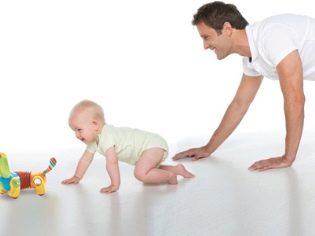When and how many months does the baby begin to crawl and sit?
When a baby appears in the family, parents are eagerly waiting for them to learn to smile, hold their heads, then roll over, sit down and crawl. The next big event will certainly be the first steps. Each new skill is of great importance, and therefore moms and dads are very sensitive to the timing of the emergence of certain motor skills. In this article, we will talk about the time frame for the child to start sitting and crawling and whether it is possible to influence these skills.
Physiology skills
It’s quite difficult to answer the question of parents when exactly the baby should master the crawling movements and the seat. Each peanut - individuality, personality, which develops according to its own laws and schemes. Therefore, all the tables with standards exist only for pediatricians, since the pediatrician sees your baby as one of the average babies. But this is only at first glance.
A thoughtful specialist will never declare a delay in physical development on the basis that the baby does not sit at 7 months or does not crawl at 8 months, because the child may have many reasons.
The baby begins to crawl and sit when its bone, muscular systems, as well as the ligaments and joints involved in these processes, have matured and strengthened sufficiently. For the crawling skill, you need developed abdominal and neck muscles, arms and legs; for sitting, you need sufficiently strong muscles in your back, abdomen, neck and arms. Naturally, no newborn has such muscles, they grow and grow stronger as the child grows. If parents from the first days pay enough attention to the physical development of infants, do massage and conduct age-related exercises, then the chances of an earlier mastering of new skills are noticeably increased.
According to the average norms, the average healthy children begin to sit after six months, at 7 months with support, and at 8 - without support. By 10 months, babies usually do an excellent job with a difficult task - to sit down from a prone position. With crawling, everything is somewhat more complicated - some children bypass this stage altogether, and some start with it. The average norms in pediatrics say that a child can learn to crawl from 5 months on the abdomen, from 7 months to 9 months - on all fours.
But the norms are norms, and your child, it is possible, has its own plans for further development, especially since many factors influence the speed of mastering new motor skills.
What can have an impact?
The first thing that matters is the well-being and state of health of your baby. If the crumb was born prematurely, it is much later than his peers will begin to comprehend the wisdom of a change in body position in space. Not because he is lazier, weaker, but because his bone and muscle tissue takes more time to prepare for a new type of load. The child himself is not the enemy, he will never think of doing what he is physically unable to do.
Painful, often sick toddler, children with congenital diseases also sit down and crawl later than healthy kids. Especially for a long time, children with neurological disorders can “sway”.
The weight of a toddler body also matters, and the most direct.The children are plump, overweight, have quite natural difficulties with keeping their own weight in the new position, their spine simply does not provide for a new load in such a volume, it needs a little more time to prepare. They crawl and sit down, but later.
The character and innate temperament of the baby dictate his behavior and motivation. Drowsy, somewhat sluggish and lazy phlegmatic and melancholic people sit, crawl and walk later than mobile, active, curious representatives of the sanguine or choleric personality type.
Much depends on the conditions for the development of the child created by the parents themselves. And this is probably the only thing that mom and dad, worrying about the development of the child, can have a direct impact. A child who is more often kept in a crib or playpen during wakefulness is unlikely to have enough motivation to start exploring the world. For the time being, he will be quite comfortable in a confined space.
There will simply be no need to sit or crawl somewhere in the crumbs, mastering the skill will slow down. If the parents provide for the baby a certain freedom of movement during waking periods, hang toys at a certain distance from him, then the baby will need to get to them, and therefore he will simply have to look for ways to do it. There are two ways - to get from a sitting or crawl position and take it. Naturally, a certain freedom of the baby needs in constant control by adults, so that the crumb is not injured.
Boys or girls - who is faster?
In thematic forums and in communication with each other, mothers often attribute certain abilities to sons and daughters. They say that girls learn new skills faster, because boys are more lazy. Another view is that girls need to sit down later than boys because of the possible dangerous effects on reproductive health.
In fact, there is no scientifically explainable difference between the development of physical skills in infants of both sexes. Children develop at about the same speed, provided that they are healthy, full-term, have no problems with overeating and overweight. Regarding the sitting down of girls and boys should be said that and those and others are not recommended to sit down at least until six months. Totally. No
The consequences can be quite sad - the pelvic bones can be injured. In this case, girls may have problems in the future with carrying their own children. And for the boy such an injury is highly undesirable.
Can I teach children skills?
This question is the most important. For some reason, it is believed that a mother who just waits for the child to sit down or crawl is irresponsible and callous. But the mother hen, who cannot wait and almost from 3 months begins to prepare the child for sitting and crawling, and best of all at once for walking, is well done and an example to follow. Formation of such a stereotype contributes to a large extent to women's forums, after five minutes of presence on which a normal mother becomes a nervous woman with an inferiority complex and a sense of guilt.
Is it normal to do nothing? Yes, it is normal. Many pediatricians, including Dr. Komarovsky, whose professional advice is trusted by millions of mothers around the world, have argued that the skills of sitting and crawling must be a completely natural way and at that age, which for this purpose is provided by nature in relation to a particular child.
Excessive activity of parents who “help” the child is often harmed - dynamic gymnastics, inaccurate exercise, forced sitting down are fraught with serious injuries. First of all, with early verticalization, the spine of a baby suffers, which is not ready for a vertical load.Compressional deformities of the vertebrae may occur, and intervertebral hernia may appear later. Many children, who were soon squatted or placed on four limbs for crawling, later manifest scoliosis, kyphosis, lordosis, gait disturbances, limb deformity. This is especially true of children who spent a lot of time at an early age hanging in jumpers, and then stomping in walkers.
Parents invented enough methods to “help” young children. Now pediatricians urge them to come to their senses and give the kids the opportunity to develop independently.
What then help, you ask. Do daily fortifying massage, include in it receptions on quite certain groups of muscles - on a back, on a stomach, on hands and legs, on neck muscles. Do exercises, gymnastics, include exercises in the complexes, which again promote the development of the necessary muscle groups, but not the mechanical acquisition of a new skill.
In order for a child to quickly master new movements independently, he must better keep a balance, therefore his vestibular apparatus must be developed. Exercises on a gymnastic ball (fitball) will help. Communicate with your child more often, teach him to be interested in the world around him, show how many interesting things he has, and then the kid will certainly have an incentive to learn new skills.
Bathe the child, temper, often walk on the street, do not overfeed him. Visit the doctor in time and do not self-medicate. He will do the rest himself. Severe pathologies of the musculoskeletal system, which prevent sitting or crawling, are rare. About them, parents usually become known almost immediately after the birth of the baby. If you have not voiced such diagnoses, calm down and just wait.
It’s worthwhile to sound the alarm if the child doesn’t fit into accepted norms in his development and what could be a significant deviation from these norms, see the next video from Dr. Komarovsky.





















